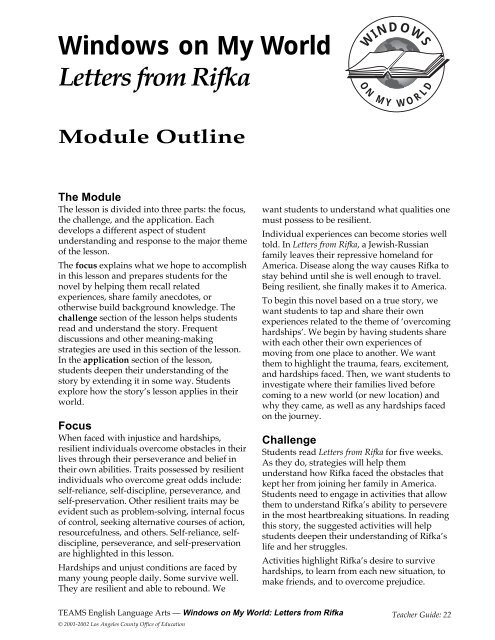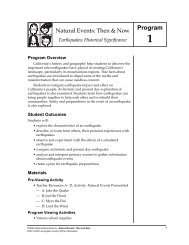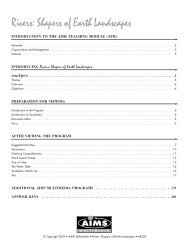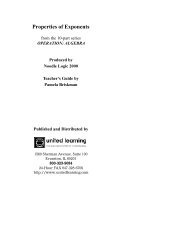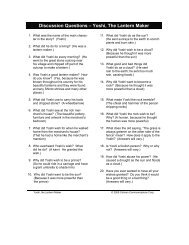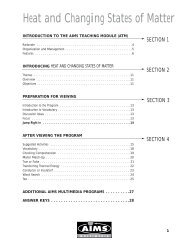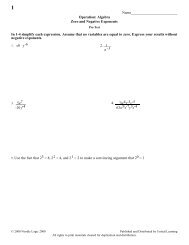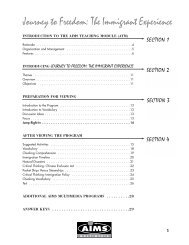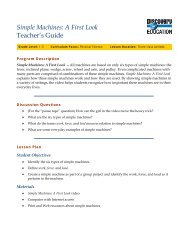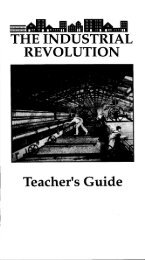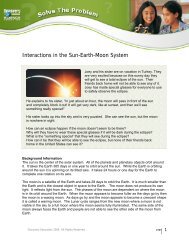Windows on My World Letters from Rifka - Discovery Education
Windows on My World Letters from Rifka - Discovery Education
Windows on My World Letters from Rifka - Discovery Education
You also want an ePaper? Increase the reach of your titles
YUMPU automatically turns print PDFs into web optimized ePapers that Google loves.
<str<strong>on</strong>g>Windows</str<strong>on</strong>g> <strong>on</strong> <strong>My</strong> <strong>World</strong><strong>Letters</strong> <strong>from</strong> <strong>Rifka</strong>O NWINDOWSM YW O R L DModule OutlineThe ModuleThe less<strong>on</strong> is divided into three parts: the focus,the challenge, and the applicati<strong>on</strong>. Eachdevelops a different aspect of studentunderstanding and resp<strong>on</strong>se to the major themeof the less<strong>on</strong>.The focus explains what we hope to accomplishin this less<strong>on</strong> and prepares students for thenovel by helping them recall relatedexperiences, share family anecdotes, orotherwise build background knowledge. Thechallenge secti<strong>on</strong> of the less<strong>on</strong> helps studentsread and understand the story. Frequentdiscussi<strong>on</strong>s and other meaning-makingstrategies are used in this secti<strong>on</strong> of the less<strong>on</strong>.In the applicati<strong>on</strong> secti<strong>on</strong> of the less<strong>on</strong>,students deepen their understanding of thestory by extending it in some way. Studentsexplore how the story’s less<strong>on</strong> applies in theirworld.FocusWhen faced with injustice and hardships,resilient individuals overcome obstacles in theirlives through their perseverance and belief intheir own abilities. Traits possessed by resilientindividuals who overcome great odds include:self-reliance, self-discipline, perseverance, andself-preservati<strong>on</strong>. Other resilient traits may beevident such as problem-solving, internal focusof c<strong>on</strong>trol, seeking alternative courses of acti<strong>on</strong>,resourcefulness, and others. Self-reliance, selfdiscipline,perseverance, and self-preservati<strong>on</strong>are highlighted in this less<strong>on</strong>.Hardships and unjust c<strong>on</strong>diti<strong>on</strong>s are faced bymany young people daily. Some survive well.They are resilient and able to rebound. Wewant students to understand what qualities <strong>on</strong>emust possess to be resilient.Individual experiences can become stories welltold. In <strong>Letters</strong> <strong>from</strong> <strong>Rifka</strong>, a Jewish-Russianfamily leaves their repressive homeland forAmerica. Disease al<strong>on</strong>g the way causes <strong>Rifka</strong> tostay behind until she is well enough to travel.Being resilient, she finally makes it to America.To begin this novel based <strong>on</strong> a true story, wewant students to tap and share their ownexperiences related to the theme of ‘overcominghardships’. We begin by having students sharewith each other their own experiences ofmoving <strong>from</strong> <strong>on</strong>e place to another. We wantthem to highlight the trauma, fears, excitement,and hardships faced. Then, we want students toinvestigate where their families lived beforecoming to a new world (or new locati<strong>on</strong>) andwhy they came, as well as any hardships faced<strong>on</strong> the journey.ChallengeStudents read <strong>Letters</strong> <strong>from</strong> <strong>Rifka</strong> for five weeks.As they do, strategies will help themunderstand how <strong>Rifka</strong> faced the obstacles thatkept her <strong>from</strong> joining her family in America.Students need to engage in activities that allowthem to understand <strong>Rifka</strong>’s ability to perseverein the most heartbreaking situati<strong>on</strong>s. In readingthis story, the suggested activities will helpstudents deepen their understanding of <strong>Rifka</strong>’slife and her struggles.Activities highlight <strong>Rifka</strong>’s desire to survivehardships, to learn <strong>from</strong> each new situati<strong>on</strong>, tomake friends, and to overcome prejudice.TEAMS English Language Arts — <str<strong>on</strong>g>Windows</str<strong>on</strong>g> <strong>on</strong> <strong>My</strong> <strong>World</strong>: <strong>Letters</strong> <strong>from</strong> <strong>Rifka</strong>© 2001-2002 Los Angeles County Office of Educati<strong>on</strong>Teacher Guide: 22
<str<strong>on</strong>g>Windows</str<strong>on</strong>g> <strong>on</strong> <strong>My</strong> <strong>World</strong><strong>Letters</strong> <strong>from</strong> <strong>Rifka</strong>O NWINDOWSM YW O R L DIt is important that the students keep theirwriting resp<strong>on</strong>se in a journal so they will beable to find evidence to support their asserti<strong>on</strong>sas they write their essay. Keeping the resiliencychart all the way through the novel providesexamples and support as they write.Applicati<strong>on</strong>In this secti<strong>on</strong> of this less<strong>on</strong>, students are askedto further extend their understanding of theresiliency factors that helped <strong>Rifka</strong> face theinjustices and hardships of her trip to America.They pers<strong>on</strong>alize these factors by c<strong>on</strong>sideringwhere resiliency factors are manifested in theirlives. Finally, students can write anautobiographical incident essay in which theyshow how they were able to successfully face ahardship or an injustice situati<strong>on</strong>. They also canwrite a speculati<strong>on</strong> about effect which allowsthe students to c<strong>on</strong>sider what could reas<strong>on</strong>ablyhappen next in the story.Module Time LineThere are nine parts to this module includingthe five programs and other suggestedactivities before, between, and bey<strong>on</strong>d theprograms. In the outline that follows, the firstcolumn c<strong>on</strong>tains a suggested pacing schedulebeginning <strong>on</strong>e and <strong>on</strong>e-half weeks before thefirst program viewing. The sec<strong>on</strong>d columnincludes the name of the less<strong>on</strong> secti<strong>on</strong>. Thepossible activities for each collecti<strong>on</strong> of lettersin the book is listed next. The followingsuggested pacing schedule has identified theactivities planned for the days preceding andfollowing each program.TEAMS English Language Arts — <str<strong>on</strong>g>Windows</str<strong>on</strong>g> <strong>on</strong> <strong>My</strong> <strong>World</strong>: <strong>Letters</strong> <strong>from</strong> <strong>Rifka</strong>© 2001-2002 Los Angeles County Office of Educati<strong>on</strong>Teacher Guide: 23
<str<strong>on</strong>g>Windows</str<strong>on</strong>g> <strong>on</strong> <strong>My</strong> <strong>World</strong><strong>Letters</strong> <strong>from</strong> <strong>Rifka</strong>O NWINDOWSM YW O R L DPacing ScheduleSuggestedPacingActivitiesNovelPagesGuidePagesPre-viewingFocusDay #1 Word Web TG:44-45Day #2 Clarify Definiti<strong>on</strong>s TG:46Resiliency Bulletin BoardTG:47; SR:4Day #3 Oral Narrative TG:48Story FrameTG:49Day #4 Foursquare TG:50Day #5 I Am Poem TG:51; SR:1Day #6 Preview of a Book 1-9 TG:52Day #7 Double Entry Reading Journal 10-15 TG:53; SR:3Program #1FocusIntroducti<strong>on</strong>Your Time #1: Retell Your Story SR:2MappingYour Time #2: Double Entry Reading JournalSharingWord Map SR:12Creating PicturesTG:55Picture of Train Stati<strong>on</strong>What Good Readers DoBetween Programs #1 & 2Day #9 Sept 3, 1919 QAR 16–20 TG:56Day #10 Oct 5, 1919 Stop and Talk 21–25 TG:57Day #11 Nov 3, 1919 <strong>Rifka</strong>'s Family Tree 26–32 TG:58Day #12 Family History Interview TG:59Class Resiliency ProfileTG:60; SR:4TG: Teacher Guide SR: Student ResourcesTEAMS English Language Arts — <str<strong>on</strong>g>Windows</str<strong>on</strong>g> <strong>on</strong> <strong>My</strong> <strong>World</strong>: <strong>Letters</strong> <strong>from</strong> <strong>Rifka</strong>© 2001-2002 Los Angeles County Office of Educati<strong>on</strong>Teacher Guide: 24
<str<strong>on</strong>g>Windows</str<strong>on</strong>g> <strong>on</strong> <strong>My</strong> <strong>World</strong><strong>Letters</strong> <strong>from</strong> <strong>Rifka</strong>O NWINDOWSM YW O R L DPacing Schedule (c<strong>on</strong>t'd.)SuggestedPacingActivitiesNovelPagesGuidePagesProgram #2FocusIntroducti<strong>on</strong>—ShareYour Time #1: QuickwriteDiscussi<strong>on</strong>Your Time #2: Resiliency Chart SR:4Your Time #3: Resiliency Chart for <strong>Rifka</strong> SR:5Resp<strong>on</strong>ding Through a LetterWhat Good Readers DoBetween Programs #2 & #3Day #13 Nov 27, 1919 Generating Your Own Questi<strong>on</strong>s 33-40 TG:62Day #14 Nov 30, 1919 Predicting 41-50 TG:63Dec 1, 1919Day #15 Feb 25, 1919 Interior M<strong>on</strong>ologue 51–60 TG:64Venn Diagram 51-60 TG:65Day #16 Mar 17, 1920 Acts of Kindness 61-65 TG:66Brainstorming 66-70 TG:67Program #3FocusIntroducti<strong>on</strong>Sharing of <strong>Letters</strong> & Interior M<strong>on</strong>ologueResp<strong>on</strong>d to QuoteYour Time #1: Hot SeatTG:68Background KnowledgeYour Time #2: C<strong>on</strong>structing a Time Line SR:11Good Reader ChartTG: Teacher Guide SR: Student ResourcesTEAMS English Language Arts — <str<strong>on</strong>g>Windows</str<strong>on</strong>g> <strong>on</strong> <strong>My</strong> <strong>World</strong>: <strong>Letters</strong> <strong>from</strong> <strong>Rifka</strong>© 2001-2002 Los Angeles County Office of Educati<strong>on</strong>Teacher Guide: 25
<str<strong>on</strong>g>Windows</str<strong>on</strong>g> <strong>on</strong> <strong>My</strong> <strong>World</strong><strong>Letters</strong> <strong>from</strong> <strong>Rifka</strong>O NWINDOWSM YW O R L DPacing Schedule (c<strong>on</strong>t'd.)SuggestedPacingActivitiesNovelPagesGuidePagesBetween Programs #3 & #4Day #18 Sept 14, 1920 Dramatizati<strong>on</strong> 71-80 TG:69Day #19 Sept 21, 1920 Dialoguing With the Text 81-88 TG:70Extended text 61-65 TG:73Day #20 Oct 1, 1920 Double Entry Journal 89-96 SR:3Poem of Emma LazarusSR:13TG:71Day #21 Oct 2, 1920 Graphic Representati<strong>on</strong> 97-103 TG:71Program #4FocusIntroducti<strong>on</strong>-Share Storyboard SR:10of their dramaYour Time #1: K-W-L Chart SR:7Your Time #2: Multiple Sources SR:8Historical Note 147-148Your Time #3: Primary SourcesGood Reader ChartBetween Programs #4 & #5Day #23 Oct 9, 1920 Silent C<strong>on</strong>versati<strong>on</strong> 104-112 TG:73Day #24 Oct 11, 1920 Overcoming Prejudice 113-119 TG:74Day #25 Oct 14, 1920 Speculative Dramatizati<strong>on</strong> 120-128Day #26 Oct 22, 1920 Initial Resp<strong>on</strong>se 129-145 TG:76Letter FrameTG:75TG: Teacher Guide SR: Student ResourcesTEAMS English Language Arts — <str<strong>on</strong>g>Windows</str<strong>on</strong>g> <strong>on</strong> <strong>My</strong> <strong>World</strong>: <strong>Letters</strong> <strong>from</strong> <strong>Rifka</strong>© 2001-2002 Los Angeles County Office of Educati<strong>on</strong>Teacher Guide: 26
<str<strong>on</strong>g>Windows</str<strong>on</strong>g> <strong>on</strong> <strong>My</strong> <strong>World</strong><strong>Letters</strong> <strong>from</strong> <strong>Rifka</strong>O NWINDOWSM YW O R L DPacing Schedule (c<strong>on</strong>t'd.)SuggestedPacingActivitiesNovelPagesGuidePagesProgram #5Applicati<strong>on</strong>Introducti<strong>on</strong>—Share Initial Resp<strong>on</strong>seYour Time #1: “I Am” <strong>Rifka</strong> SR:6Speculati<strong>on</strong> About Effects Essay"What will <strong>Rifka</strong> do next?"TG:77SR:9Your Time #2: BrainstormingTG:67Your Time #3: QuickwriteWhat Good Readers DoExtending the Less<strong>on</strong>Post-Viewing ActivitiesDay #27Speculati<strong>on</strong> About Effects Revisi<strong>on</strong>Day #28Day #29 Autobiographical Incident Essay TG:78TG:79Day #30 SR:9Day #31 Changes in Genré TG:80Genré PerformancesTG: Teacher Guide SR: Student ResourcesTEAMS English Language Arts — <str<strong>on</strong>g>Windows</str<strong>on</strong>g> <strong>on</strong> <strong>My</strong> <strong>World</strong>: <strong>Letters</strong> <strong>from</strong> <strong>Rifka</strong>© 2001-2002 Los Angeles County Office of Educati<strong>on</strong>Teacher Guide: 27
<str<strong>on</strong>g>Windows</str<strong>on</strong>g> <strong>on</strong> <strong>My</strong> <strong>World</strong><strong>Letters</strong> <strong>from</strong> <strong>Rifka</strong>O NWINDOWSM YW O R L DProgram Viewing #1Building Background KnowledgeProgram OverviewIn program #1, students are oriented to animportant theme present in <strong>Letters</strong> <strong>from</strong> <strong>Rifka</strong>,the trauma involved in the movement of afamily <strong>from</strong> <strong>on</strong>e place to another. The novel isintroduced by the studio teacher reading a fewpages describing a scene which studentsc<strong>on</strong>struct a mental image of what the trainstati<strong>on</strong> might look like.Key OutcomesAs a result of this program, students will:• see the relati<strong>on</strong>ship of their familystories and history to <strong>Letters</strong> <strong>from</strong> <strong>Rifka</strong>• speculate about <strong>Rifka</strong>’s family members'thoughts• begin to picture scenes <strong>from</strong> the novel• know three of the things good readersdo• practice generating their own questi<strong>on</strong>sPre-viewing Preparati<strong>on</strong>For best results, it is recommended that teachersuse all pre-viewing activities. These activitieswill take about <strong>on</strong>e week to complete andemphasize both the relati<strong>on</strong>ship of familyhistories to <strong>Letters</strong> <strong>from</strong> <strong>Rifka</strong> as well asintroduce the four resiliency traits trackedthroughout the novel. Interviewing of familymembers regarding a move, pre-viewing thebook, and reading of the first 15 pages shouldalso precede the first program viewing.Because a resp<strong>on</strong>se journal may be a newstrategy for many students, teachers shouldprovide some experience with this writingstrategy that helps students deal with thecomplexities in the novel. Many of theseresp<strong>on</strong>ses will be written in resp<strong>on</strong>se toinferences. Teachers need to model for studentshow to "fill in the gaps." Many strugglingreaders are not aware that all the answers toquesti<strong>on</strong>s they have are not in the book. This isan interacti<strong>on</strong> between the reader and the text.Materials needed for Program #1• <strong>Letters</strong> <strong>from</strong> <strong>Rifka</strong>• colored markers and plain paper• resp<strong>on</strong>se journal• Retell Your Story (SR:2)• I AM poem (SR:1)• Double Entry Journal (SR:3)• Word Map (SR:12)Post ViewingThroughout the reading of <strong>Letters</strong> <strong>from</strong> <strong>Rifka</strong>,SR:10, Story Board, can be used to help focusstudents <strong>on</strong> the sequence of events. Quotes canbe used as indicated <strong>on</strong> SR:10, or to addvariety, a larger sheet can be used forillustrati<strong>on</strong>s.TEAMS English Language Arts — <str<strong>on</strong>g>Windows</str<strong>on</strong>g> <strong>on</strong> <strong>My</strong> <strong>World</strong>: <strong>Letters</strong> <strong>from</strong> <strong>Rifka</strong>© 2001-2002 Los Angeles County Office of Educati<strong>on</strong>Teacher Guide: 28
<str<strong>on</strong>g>Windows</str<strong>on</strong>g> <strong>on</strong> <strong>My</strong> <strong>World</strong><strong>Letters</strong> <strong>from</strong> <strong>Rifka</strong>O NWINDOWSM YW O R L DProgram Viewing #1 OutlineFor the Teacher Mode ScriptBe sure to have <strong>Letters</strong> <strong>from</strong> <strong>Rifka</strong>available for students to read al<strong>on</strong>g withthe Studio Teacher.Students should have alreadyinterviewed their families to find a storyabout the time a family member moved<strong>from</strong> <strong>on</strong>e place to another. With somefamilies with immigrati<strong>on</strong> histories thatare recent, their movement to the UntiedStates can be solicited. For others forwhom this history was distant orunknown, have students share anexample of movement <strong>from</strong> <strong>on</strong>e town toanother, or <strong>from</strong> <strong>on</strong>e neighborhood toanother, or perhaps <strong>from</strong> <strong>on</strong>e school orclassroom to another.TV M<strong>on</strong>itorStudio Teacher (ST)Sharing of stories should be succinct. Your Time #1ClassroomWelcome: Introducti<strong>on</strong> of program intent.Talk briefly and informally about theless<strong>on</strong>.Share how good readers bring their ownstories to literature they read.Begin with sharing how/why a familymember moved <strong>from</strong> <strong>on</strong>e locati<strong>on</strong> toanother. (This should be the result of afamily interview.)Retell Your StoryShare your family story about moving<strong>from</strong> <strong>on</strong>e locati<strong>on</strong> to another.Who moved?Why did they move?Where?What adversity did they face?How did they overcome problemsencountered?How was life in the new area?Sharing of stories.— Who was the pers<strong>on</strong> and his/herrelati<strong>on</strong>ship to the student?— What circumstances did they face inthe old country?— Describe the move.— Where did they settle?Show a story <strong>from</strong> the Web page. Sharebook "Ellis Island Oral History Project"TEAMS English Language Arts — <str<strong>on</strong>g>Windows</str<strong>on</strong>g> <strong>on</strong> <strong>My</strong> <strong>World</strong>: <strong>Letters</strong> <strong>from</strong> <strong>Rifka</strong>© 2001-2002 Los Angeles County Office of Educati<strong>on</strong>Teacher Guide: 29
<str<strong>on</strong>g>Windows</str<strong>on</strong>g> <strong>on</strong> <strong>My</strong> <strong>World</strong><strong>Letters</strong> <strong>from</strong> <strong>Rifka</strong>O NWINDOWSM YW O R L DProgram Viewing #1 Outline (c<strong>on</strong>'t.)For the Teacher Mode ScriptHave a world map available.Ask students to open their books to page1 and to read al<strong>on</strong>g with the StudioTeacher. Resp<strong>on</strong>d to quote.Guest StudentsFind Berdichev in the map and tracejourney through Poland.The ST reads the secti<strong>on</strong> about <strong>Rifka</strong> andmodels her thinking about the quote "If ithad not been for your father."Help students to resp<strong>on</strong>d to quote in adouble entry journal.Students generate their own questi<strong>on</strong>sabout the first page.StudioStudio TeacherYour Time #2ClassroomST models how to resp<strong>on</strong>d to a quote.In small groups, generate your ownquesti<strong>on</strong>s about what is said <strong>on</strong> page 1.Have 11X14 paper available for thestudents.AssignmentIntroducti<strong>on</strong> of drawing a picture of therailroad stati<strong>on</strong> as an after Programactivity.Have students follow al<strong>on</strong>g or just listen. Studio Teacher The ST reads the secti<strong>on</strong> that describes thescene at the railroad, p. 2-3.Have the chart paper ready to c<strong>on</strong>structa chart and What Good Readers Do.RereadGenerate questi<strong>on</strong>sMake picturesStudio TeacherStudio TeacherLead discussi<strong>on</strong> <strong>on</strong> the strategies of goodreaders use.Have students listen as to why it isimportant to read.Encourage students to send in theirstudent work and book reviews.Studio TeacherBook TalksStudio TeacherClosingStudents need to read 1,000,000 words ayear. It is important to have kids talkabout books.Share the Web site.I hear and I forgetI see and I rememberI do and I understand.- Chinese ProverbTEAMS English Language Arts — <str<strong>on</strong>g>Windows</str<strong>on</strong>g> <strong>on</strong> <strong>My</strong> <strong>World</strong>: <strong>Letters</strong> <strong>from</strong> <strong>Rifka</strong>© 2001-2002 Los Angeles County Office of Educati<strong>on</strong>Teacher Guide: 30
<str<strong>on</strong>g>Windows</str<strong>on</strong>g> <strong>on</strong> <strong>My</strong> <strong>World</strong><strong>Letters</strong> <strong>from</strong> <strong>Rifka</strong>O NWINDOWSM YW O R L DProgram Viewing #2Initial Resp<strong>on</strong>se to the StoryProgram OverviewIn program #2, students examine four charactertraits associated with resiliency in <strong>Letters</strong> <strong>from</strong><strong>Rifka</strong> (self-reliance, self-discipline, perseverance,and self-preservati<strong>on</strong>). Students begin byrecalling a time when they were ill. They relatethis incident to the resiliency factors. Next, theystudy these traits in <strong>Rifka</strong> and how she handlesadversity.Materials needed for Program #2• <strong>Letters</strong> <strong>from</strong> <strong>Rifka</strong>• marking pen or pencil• several sheets of clear paper• two resiliency charts (SR:4-5)Key OutcomesAs a result of this program, students will:• relate incidents in their own lives to<strong>Rifka</strong>’s• understand how <strong>Rifka</strong> possessed fourresiliency traits which made her str<strong>on</strong>g• learn how a writer comes to write abook• c<strong>on</strong>tinue to learn how to developquesti<strong>on</strong>s when they readPre-viewing Preparati<strong>on</strong>For best results, it is recommended thatteachers follow the suggested reading andactivity schedule between Programs #1 and #2.Read pages 16–32 in <strong>Letters</strong> <strong>from</strong> <strong>Rifka</strong> andcomplete the appropriate activities provided inthe guide.TEAMS English Language Arts — <str<strong>on</strong>g>Windows</str<strong>on</strong>g> <strong>on</strong> <strong>My</strong> <strong>World</strong>: <strong>Letters</strong> <strong>from</strong> <strong>Rifka</strong>© 2001-2002 Los Angeles County Office of Educati<strong>on</strong>Teacher Guide: 31
<str<strong>on</strong>g>Windows</str<strong>on</strong>g> <strong>on</strong> <strong>My</strong> <strong>World</strong><strong>Letters</strong> <strong>from</strong> <strong>Rifka</strong>O NWINDOWSM YW O R L DProgram Viewing #2 OutlineFor the Teacher Mode ScriptStudioStudio TeacherIntroducti<strong>on</strong> of program intent andoverview of activities.Discussi<strong>on</strong> of quickwrite intent andprocedure.Quickwrites are uninterrupted writing tofind out what students know, think,remember, or believe about a topic,situati<strong>on</strong>, event, etc. This procedure is'pen to paper' with no pausing to worryabout penmanship, punctuati<strong>on</strong>, orsentence structure.Your Time #1ClassroomQuickwriteAfter having read <strong>Rifka</strong>’s letters ofSeptember 3, 1919 and November 3, 1919,do a quickwrite about a time your weresick. How did you feel? What did you doto help yourself? Who or what providedcomfort? Were your feelings similar to<strong>Rifka</strong>’s?Discussi<strong>on</strong> about resiliencySelf-RelianceSelf-DisciplinePerseveranceSelf-Preservati<strong>on</strong>Your students should be familiar withthese four resiliency traits. This reviewprepares your students for thediscussi<strong>on</strong> that is to follow. DistributeStudent Resources, p. 4.Duplicate the resiliency chart availablein the Student Resources, p.5.Your Time #2ClassroomStudioStudio TeacherYour Time #3ClassroomDiscussi<strong>on</strong>In small groups, students share theirquickwrites and record <strong>on</strong> StudentReources, p. 4 how their ancedotes are anexample of the resiliency factors.Explanati<strong>on</strong> of how to c<strong>on</strong>struct aresiliency chart.Resiliency chartC<strong>on</strong>struct a resiliency chart for <strong>Rifka</strong>.This activity will be completed outsideof the Program Viewing time.StudioStudio TeacherStudio TeacherStudio Teacher introduces Resp<strong>on</strong>dingThrough a Letter activity homework.Reads aloud p. 31 and discuss whatquesti<strong>on</strong>s they have.TEAMS English Language Arts — <str<strong>on</strong>g>Windows</str<strong>on</strong>g> <strong>on</strong> <strong>My</strong> <strong>World</strong>: <strong>Letters</strong> <strong>from</strong> <strong>Rifka</strong>© 2001-2002 Los Angeles County Office of Educati<strong>on</strong>Teacher Guide: 32
<str<strong>on</strong>g>Windows</str<strong>on</strong>g> <strong>on</strong> <strong>My</strong> <strong>World</strong><strong>Letters</strong> <strong>from</strong> <strong>Rifka</strong>O NWINDOWSM YW O R L DProgram Viewing #2 Outline (c<strong>on</strong>t'd.)For the Teacher Mode ScriptStudents brainstorm what they didtodayAdd to the Good Readers chartMake c<strong>on</strong>necti<strong>on</strong>sDetermine what is importantSome students may not have written aletter previously. In this event, you mayfind it useful to provide assistanceregarding format (date, inside address,greeting, and closing), c<strong>on</strong>tent(menti<strong>on</strong>ing <strong>Rifka</strong>’s c<strong>on</strong>cerns and usingresiliency factors to encourage her toremain str<strong>on</strong>g).Your Time #3StudioStudio TeacherStudio TeacherStudioStudio Teacher<strong>Rifka</strong> writes “I amafraid, too but not soafraid that I want tocome back.”What did we do today?Help students to reflect <strong>on</strong> what they didduring the broadcast and c<strong>on</strong>struct a goodreaders chart.Author’s study of how Kar<strong>on</strong> Hesse cameto write <strong>Letters</strong> <strong>from</strong> <strong>Rifka</strong>.Resp<strong>on</strong>ding Through a Letter: After readingthe letter dated November 3, 1919, havestudents pretend to be <strong>Rifka</strong>’s cousinTovah and write a letter to <strong>Rifka</strong>. Whatwould Tovah say to <strong>Rifka</strong>? How can shehelp <strong>Rifka</strong>? Ask students to stress theresiliency factors they can already see in<strong>Rifka</strong> as a means to encourage her. Beprepared to share next week.Have students in your class share theirfavorite books sometime this week. Giveeach child 30 sec<strong>on</strong>ds to do this.TEAMS English Language Arts — <str<strong>on</strong>g>Windows</str<strong>on</strong>g> <strong>on</strong> <strong>My</strong> <strong>World</strong>: <strong>Letters</strong> <strong>from</strong> <strong>Rifka</strong>© 2001-2002 Los Angeles County Office of Educati<strong>on</strong>Teacher Guide: 33
<str<strong>on</strong>g>Windows</str<strong>on</strong>g> <strong>on</strong> <strong>My</strong> <strong>World</strong><strong>Letters</strong> <strong>from</strong> <strong>Rifka</strong>O NWINDOWSM YW O R L DProgram Viewing #3Deepening the UnderstandingProgram OverviewIn program #3, students have an opportunity toask questi<strong>on</strong>s of a student playing the role of<strong>Rifka</strong>. In additi<strong>on</strong>, student use n<strong>on</strong>ficti<strong>on</strong>material to add to their understanding.Key OutcomesAs a result of this program, students will:• see how <strong>Rifka</strong>’s resiliency helped herthrough troubling times• assume the role of <strong>Rifka</strong>• understand choices available to <strong>Rifka</strong>and the potential c<strong>on</strong>sequences of each• resp<strong>on</strong>d to quotes in a double-entryjournal• begin to c<strong>on</strong>struct a time line• learn 3 different kinds of questi<strong>on</strong>sMaterials needed for Program #3• <strong>Letters</strong> <strong>from</strong> <strong>Rifka</strong>• pen or pencil• several sheets of plain paper• journal• letters students have written to Tovah• resiliency charts• Time Line (SR:11)Pre-viewing Preparati<strong>on</strong>For best results, it is recommended that teachersfollow the suggested reading and activityschedule between Programs #2 and #3: Readpages 33–70 and complete the recommendedactivities in this guide.TEAMS English Language Arts — <str<strong>on</strong>g>Windows</str<strong>on</strong>g> <strong>on</strong> <strong>My</strong> <strong>World</strong>: <strong>Letters</strong> <strong>from</strong> <strong>Rifka</strong>© 2001-2002 Los Angeles County Office of Educati<strong>on</strong>Teacher Guide: 34
<str<strong>on</strong>g>Windows</str<strong>on</strong>g> <strong>on</strong> <strong>My</strong> <strong>World</strong><strong>Letters</strong> <strong>from</strong> <strong>Rifka</strong>O NWINDOWSM YW O R L DProgram Viewing #3 OutlineFor the Teacher Mode ScriptMake a chart for the classroom of the 3kind of questi<strong>on</strong>s.Resp<strong>on</strong>d to quote.StudioStudio TeacherStudio TeacherYour Time #1Introducti<strong>on</strong>.Share letters written to Tovah.Using Questi<strong>on</strong>-Answer Resp<strong>on</strong>se, QAR,help students to identify different kinds ofquesti<strong>on</strong>s.“Saying goodbye to Mama and Papa hurtin chest the way it hurts when Saul heldme underwater too l<strong>on</strong>g.’Have students’ journal open.Hot Seat is a procedure in which studentsassume the pers<strong>on</strong>a of a character <strong>from</strong>the story. They answer questi<strong>on</strong>s askedby peers as though they were thatindividual.Your Time #2ClassroomStudioStudio TeacherRoll in #1I am poem Resiliency Charts. Resp<strong>on</strong>d toSaul's quote.Introducti<strong>on</strong> to Hot Seat.Watch a clip of other students doing HotSeat.Students discuss <strong>Rifka</strong>’s pers<strong>on</strong>alcharacteristics and generate a list ofquesti<strong>on</strong>s they would ask her.Your Time #3ClassroomStudents discuss...What are your thoughts about <strong>Rifka</strong>?What questi<strong>on</strong>s would you like to askher?Have students listen or follow al<strong>on</strong>g.StudioStudio TeacherStudioVideo ClipStudioStudio TeacherStudio Teacher reads letter of October 1,1920.Nati<strong>on</strong>al Geographic Perspective in U.S.History video clip about Ellis Island orWho Built America: From the Centennial tothe Great War, 1876-1914.Introducti<strong>on</strong> of Photo Time Line.TEAMS English Language Arts — <str<strong>on</strong>g>Windows</str<strong>on</strong>g> <strong>on</strong> <strong>My</strong> <strong>World</strong>: <strong>Letters</strong> <strong>from</strong> <strong>Rifka</strong>© 2001-2002 Los Angeles County Office of Educati<strong>on</strong>Teacher Guide: 35
<str<strong>on</strong>g>Windows</str<strong>on</strong>g> <strong>on</strong> <strong>My</strong> <strong>World</strong><strong>Letters</strong> <strong>from</strong> <strong>Rifka</strong>O NWINDOWSM YW O R L DProgram Viewing #3 Outline (c<strong>on</strong>t'd.)For the Teacher Mode ScriptYour Time #3ClassroomBrainstorm Main PointsStudents brainstorm main points to put<strong>on</strong> timeline. What are the importantpoints up until this time in the story?Help students compare themselves to<strong>Rifka</strong>. What resiliency characteristics dothey share in comm<strong>on</strong>?Studio TeacherRead aloud Jessie Came Across the Sea orother extended text.Have Good Readers Chart availableGraph a ChartGenerate Questi<strong>on</strong>sDetermine ImportanceStudio TeacherHave students add to their strategy list.ClosingTEAMS English Language Arts — <str<strong>on</strong>g>Windows</str<strong>on</strong>g> <strong>on</strong> <strong>My</strong> <strong>World</strong>: <strong>Letters</strong> <strong>from</strong> <strong>Rifka</strong>© 2001-2002 Los Angeles County Office of Educati<strong>on</strong>Teacher Guide: 36
<str<strong>on</strong>g>Windows</str<strong>on</strong>g> <strong>on</strong> <strong>My</strong> <strong>World</strong><strong>Letters</strong> <strong>from</strong> <strong>Rifka</strong>O NWINDOWSM YW O R L DProgram Viewing #4Understanding Historical SignificanceProgram OverviewIn program #4, students develop an inquirychart as to the questi<strong>on</strong>s they have about thereas<strong>on</strong>s <strong>Rifka</strong>’s family left their homeland andmade the journey to America. Using multiplesources and primary documents, students beginto research the questi<strong>on</strong>s they have about life inRussia for the Jewish people at that time andhow the Ellis Island experience was a part ofthat. Emphasis in this program is <strong>on</strong> readinginformati<strong>on</strong>al text and some different strategiesthat help students make sense of expositorytext.Key OutcomesAs a result of this program, students will:• focus <strong>on</strong> the questi<strong>on</strong>s students have <strong>on</strong>the treatment of the Jewish people inRussia in the early 1900’s• learn how to use multiple resourceswith the use of a graphic organizer• understand what primary sources areand use them to understand what lifewas like at Ellis Island in 1918Materials needed for Program #4• <strong>Letters</strong> <strong>from</strong> <strong>Rifka</strong>• pen or pencil• resp<strong>on</strong>se journal• K-W-L chart (SR:7)• Multiple Sources Chart (SR:8)• Informati<strong>on</strong>al references—variety ofinformati<strong>on</strong>al texts about Ellis Island(please see bibliography). These canborrowed <strong>from</strong> the local library.• Interior m<strong>on</strong>ologue that was written inresp<strong>on</strong>se to the letter of September 14,1920, (TG:54; TG:64)Pre-viewing Preparati<strong>on</strong>For students to be ready to do this kind ofinquiry, it is recommended that teachers followthe suggested reading and activity schedulebetween Programs #3 and #4.Read pages 71-103 and complete therecommended activities in this guide.TEAMS English Language Arts — <str<strong>on</strong>g>Windows</str<strong>on</strong>g> <strong>on</strong> <strong>My</strong> <strong>World</strong>: <strong>Letters</strong> <strong>from</strong> <strong>Rifka</strong>© 2001-2002 Los Angeles County Office of Educati<strong>on</strong>Teacher Guide: 37
<str<strong>on</strong>g>Windows</str<strong>on</strong>g> <strong>on</strong> <strong>My</strong> <strong>World</strong><strong>Letters</strong> <strong>from</strong> <strong>Rifka</strong>O NWINDOWSM YW O R L DProgram Viewing #4 OutlineFor the Teacher Mode ScriptShare resp<strong>on</strong>ses to the poem <strong>on</strong> theStatue of Liberty or the interiorm<strong>on</strong>ologue <strong>from</strong> September 14, 1920.Have a K-W-L chart ready for thestudents to record their questi<strong>on</strong>s.Facilitate the discussi<strong>on</strong> during theYour Time.Your Time #1ClassroomC<strong>on</strong>struct questi<strong>on</strong>sShare the student work.Introduce the K-W-L chart and the topic.Brainstorm what the students know aboutlife in Russia.Help the students to find the pages inChapter 1.Have the graphic organizer “MultipleSources” (SR p. 8) for each studentplus a variety of resources.Help the students to read at least <strong>on</strong>eof the sources and put down <strong>on</strong>e fact<strong>on</strong> their chart and record theirresp<strong>on</strong>se.Help students to speculate whyTovah's family didn’t leave when<strong>Rifka</strong> did.Facilitate the quickwrite.Have the primary source available forthe students to read.Facilitate the Your Time.StudioTeacherStudio TeacherYour Time #2ClassroomStudio TeacherStudentsStudio TeacherYour Time #3ClassroomRead PrimarySourcesReread the parts in Chapter 1 that willgive some informati<strong>on</strong>.Help the students get started in readingmultiple sources to find the answers totheir questi<strong>on</strong>s.Read n<strong>on</strong>-ficti<strong>on</strong> piece to answerquesti<strong>on</strong>s.Record <strong>on</strong> the K-W-L chart what we havelearned.If this was happening, why didn’t Tovah’sfamily leave?Write what they think.Another way to get informati<strong>on</strong> is primarysources.Read the diary entry to find answer fortheir questi<strong>on</strong>s.TEAMS English Language Arts — <str<strong>on</strong>g>Windows</str<strong>on</strong>g> <strong>on</strong> <strong>My</strong> <strong>World</strong>: <strong>Letters</strong> <strong>from</strong> <strong>Rifka</strong>© 2001-2002 Los Angeles County Office of Educati<strong>on</strong>Teacher Guide: 38
<str<strong>on</strong>g>Windows</str<strong>on</strong>g> <strong>on</strong> <strong>My</strong> <strong>World</strong><strong>Letters</strong> <strong>from</strong> <strong>Rifka</strong>Program Viewing #4 Outline (c<strong>on</strong>t'd.)For the Teacher Mode ScriptO NWINDOWSM YW O R L DHelp students to listen to informati<strong>on</strong><strong>on</strong> Ellis IslandStudio TeacherRead aloud a short secti<strong>on</strong> <strong>on</strong>Ellis Island.Start the students <strong>on</strong> drawing a visual<strong>on</strong> <strong>Rifka</strong>’s space at Ellis Island.Studio TeacherRead aloud secti<strong>on</strong> where <strong>Rifka</strong>is at Ellis Island.Have Good Reader Chart available andadd to it:RereadCollaborateUse multiple sourcesDetermine what is importantStudio TeacherAdd these strategies used intoday’s less<strong>on</strong>.TEAMS English Language Arts — <str<strong>on</strong>g>Windows</str<strong>on</strong>g> <strong>on</strong> <strong>My</strong> <strong>World</strong>: <strong>Letters</strong> <strong>from</strong> <strong>Rifka</strong>© 2001-2002 Los Angeles County Office of Educati<strong>on</strong>Teacher Guide: 39
<str<strong>on</strong>g>Windows</str<strong>on</strong>g> <strong>on</strong> <strong>My</strong> <strong>World</strong><strong>Letters</strong> <strong>from</strong> <strong>Rifka</strong>O NWINDOWSM YW O R L DProgram Viewing #5Extending Your UnderstandingProgram OverviewIn program #5, students explore <strong>Rifka</strong>’smotivati<strong>on</strong> and potential courses of acti<strong>on</strong>sopen to her. They reflect <strong>on</strong> the resiliency traits<strong>Rifka</strong> possessed by writing a poem.Finally, students begin writing aspeculati<strong>on</strong> about effects essay.Key OutcomesAs a result of this program, students will:• learn what a primary source is bylooking at a ship’s manifest that landedat Ellis Island in 19…• understand <strong>Rifka</strong>’s motivati<strong>on</strong> better• complete an “I Am” Poem• develop a first draft of a speculati<strong>on</strong>about effects essay• understand what an initial resp<strong>on</strong>se isMaterials needed for Program #5• <strong>Letters</strong> <strong>from</strong> <strong>Rifka</strong>• colored pen or pencil• several sheets of plain paper• “I Am” Poem (SR:6)• Speculati<strong>on</strong> About Effects assignmentsheet (SR:9)• Initial Resp<strong>on</strong>se to the novelPre-viewing Preparati<strong>on</strong>For best results, it is recommended thatteachers follow the suggested reading andactivity schedule between Programs #4 and #5.Read pages 104 - 145 and complete activitiessuggested in this guide.TEAMS English Language Arts — <str<strong>on</strong>g>Windows</str<strong>on</strong>g> <strong>on</strong> <strong>My</strong> <strong>World</strong>: <strong>Letters</strong> <strong>from</strong> <strong>Rifka</strong>© 2001-2002 Los Angeles County Office of Educati<strong>on</strong>Teacher Guide: 40
<str<strong>on</strong>g>Windows</str<strong>on</strong>g> <strong>on</strong> <strong>My</strong> <strong>World</strong><strong>Letters</strong> <strong>from</strong> <strong>Rifka</strong>O NWINDOWSM YW O R L DProgram Viewing #5 OutlineFor the Teacher Mode ScriptHave students finish reading the noveland write their initial resp<strong>on</strong>se.StudioStudio TeacherStudio TeacherIntroducti<strong>on</strong> and overview.Share their initial resp<strong>on</strong>ses that havebeen faxed to the studio.Share what a “primary source” is andhelp students learn what they can come toknow by reading a ship’s manifest.Share different books that haveinformati<strong>on</strong> <strong>on</strong> Ellis Island.Roll #1See actual footage of immigrants arrivingin Ellis Island.Have students to make a thoughtfulresp<strong>on</strong>se to the quote.Your Time #1Resp<strong>on</strong>d to quote “Ellis Island is a lineseparating my future <strong>from</strong> my past.”The “I Am” Poem was used earlier.Ask students to re-evaluate theirunderstanding of <strong>Rifka</strong> in light ofstudent comprehensi<strong>on</strong> of resiliencyfactors.Your Time #2Classroom“I Am” PoemProject understanding of <strong>Rifka</strong>, recognizeher resilient characteristics, and developfurther insights into her character bycomposing an “I Am” Poem. Studentsmay choose to work with a partner incompleting this poem <strong>from</strong> <strong>Rifka</strong>’s pointof view, do it in groups with <strong>on</strong>e groupdoing each stanza. Student groups mayselect to write the three stanzas of the “IAm” Poem for <strong>Rifka</strong> with the 1st stanzahappening in Berdichev, the sec<strong>on</strong>d inAntwerp, and the third stanza at EllisIsland.TEAMS English Language Arts — <str<strong>on</strong>g>Windows</str<strong>on</strong>g> <strong>on</strong> <strong>My</strong> <strong>World</strong>: <strong>Letters</strong> <strong>from</strong> <strong>Rifka</strong>© 2001-2002 Los Angeles County Office of Educati<strong>on</strong>Teacher Guide: 41
<str<strong>on</strong>g>Windows</str<strong>on</strong>g> <strong>on</strong> <strong>My</strong> <strong>World</strong><strong>Letters</strong> <strong>from</strong> <strong>Rifka</strong>O NWINDOWSM YW O R L DProgram Viewing #5 Outline (c<strong>on</strong>t'd.)For the Teacher Mode ScriptSpeculati<strong>on</strong> about effects writing is apowerful type of discourse. It asksstudents to take all that they know <strong>from</strong>reading <strong>Letters</strong> <strong>from</strong> <strong>Rifka</strong> and to c<strong>on</strong>siderwhat reas<strong>on</strong>ably could occur next.Direct students to the questi<strong>on</strong>s sharedby the Studio Instructor as guides tospeculati<strong>on</strong> about effects writing. Theactual writing of this essay follow theprogram..StudioStudio TeacherYour Time #3Explanati<strong>on</strong> of questi<strong>on</strong>s for writing aspeculati<strong>on</strong> about effects essay:— What was the situati<strong>on</strong>?— What do you believe will happennext?— What support do you have for thissuppositi<strong>on</strong>?— What will be the outcome?Brainstorming in groups. What they thinkmight happen to <strong>Rifka</strong> after she get toAmerica.After this program, guide your studentsthrough this writing exercise by thesuggested steps <strong>on</strong> writing a persuasiveessay.StudioStudio TeacherShare the steps of the writing process inwriting Speculati<strong>on</strong> About Effects Essay.Student Resources: 9Scoring Guide - Teacher Resources: 13Add to the Good Reader Chart• Resp<strong>on</strong>d to Text• Write Initial Resp<strong>on</strong>ses• SpeculateStudio Teacher &GuestsLead students to look back over what theyhave d<strong>on</strong>e today and add to their goodreader chart.Have students finish their essays .StudioStudio TeacherStudio Teacher talks briefly about followupactivities that each student mayperform to extend their understanding ofthe meaning of the story.ClosingTEAMS English Language Arts — <str<strong>on</strong>g>Windows</str<strong>on</strong>g> <strong>on</strong> <strong>My</strong> <strong>World</strong>: <strong>Letters</strong> <strong>from</strong> <strong>Rifka</strong>© 2001-2002 Los Angeles County Office of Educati<strong>on</strong>Teacher Guide: 42


